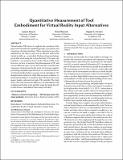Files in this item
Quantitative measurement of tool embodiment for virtual reality input alternatives
Item metadata
| dc.contributor.author | Alzayat, Ayman | |
| dc.contributor.author | Hancock, Mark | |
| dc.contributor.author | Nacenta, Miguel | |
| dc.date.accessioned | 2019-05-03T23:38:34Z | |
| dc.date.available | 2019-05-03T23:38:34Z | |
| dc.date.issued | 2019-04-18 | |
| dc.identifier | 257478767 | |
| dc.identifier | 253dc732-24c5-4084-a21e-f0dc50b9fa1c | |
| dc.identifier | 85067620897 | |
| dc.identifier | 000474467905057 | |
| dc.identifier.citation | Alzayat , A , Hancock , M & Nacenta , M 2019 , Quantitative measurement of tool embodiment for virtual reality input alternatives . in Proceedings of the 2019 CHI Conference on Human Factors in Computing Systems (CHI'19) . , 443 , ACM , New York , ACM Conference on Human Factors in Computing Systems 2019 , Glasgow , United Kingdom , 4/05/19 . https://doi.org/10.1145/3290605.3300673 | en |
| dc.identifier.citation | conference | en |
| dc.identifier.isbn | 9781450359702 | |
| dc.identifier.other | ORCID: /0000-0002-9864-9654/work/57088501 | |
| dc.identifier.uri | https://hdl.handle.net/10023/17643 | |
| dc.description | Funding: Ontario Ministry of Research and Innovation and Science and the Natural Sciences and Engineering Research Council of Canada for funding. | en |
| dc.description.abstract | Virtual reality (VR) strives to replicate the sensation of the physical environment by mimicking people’s perceptions and experience of being elsewhere. These experiences are often mediated by the objects and tools we interact with in the virtual world (e.g., a controller). Evidence from psychology posits that when using the tool proficiently, it becomes embodied (i.e., an extension of one’s body). There is little work, however, on how to measure this phenomenon in VR, and on how different types of tools and controllers can affect the experience of interaction. In this work, we leverage cognitive psychology and philosophy literature to construct the Locus-of-Attention Index (LAI), a measure of tool embodiment. We designed and conducted a study that measures readiness-to-hand and unreadiness-to-hand for three VR interaction techniques: hands, a physical tool, and a VR controller. The study shows that LAI can measure differences in embodiment with working and broken tools and that using the hand directly results in more embodiment than using controllers. | |
| dc.format.extent | 11 | |
| dc.format.extent | 3173017 | |
| dc.language.iso | eng | |
| dc.publisher | ACM | |
| dc.relation.ispartof | Proceedings of the 2019 CHI Conference on Human Factors in Computing Systems (CHI'19) | en |
| dc.subject | Embodiment | en |
| dc.subject | Tool embodiment | en |
| dc.subject | Embodied interaction | en |
| dc.subject | Virtual reality | en |
| dc.subject | Ready-to-hand | en |
| dc.subject | Unready-to-hand | en |
| dc.subject | Tools | en |
| dc.subject | QA75 Electronic computers. Computer science | en |
| dc.subject | T Technology | en |
| dc.subject | DAS | en |
| dc.subject.lcc | QA75 | en |
| dc.subject.lcc | T | en |
| dc.title | Quantitative measurement of tool embodiment for virtual reality input alternatives | en |
| dc.type | Conference item | en |
| dc.contributor.institution | University of St Andrews. School of Computer Science | en |
| dc.identifier.doi | https://doi.org/10.1145/3290605.3300673 | |
| dc.date.embargoedUntil | 2019-05-04 |
This item appears in the following Collection(s)
Items in the St Andrews Research Repository are protected by copyright, with all rights reserved, unless otherwise indicated.

